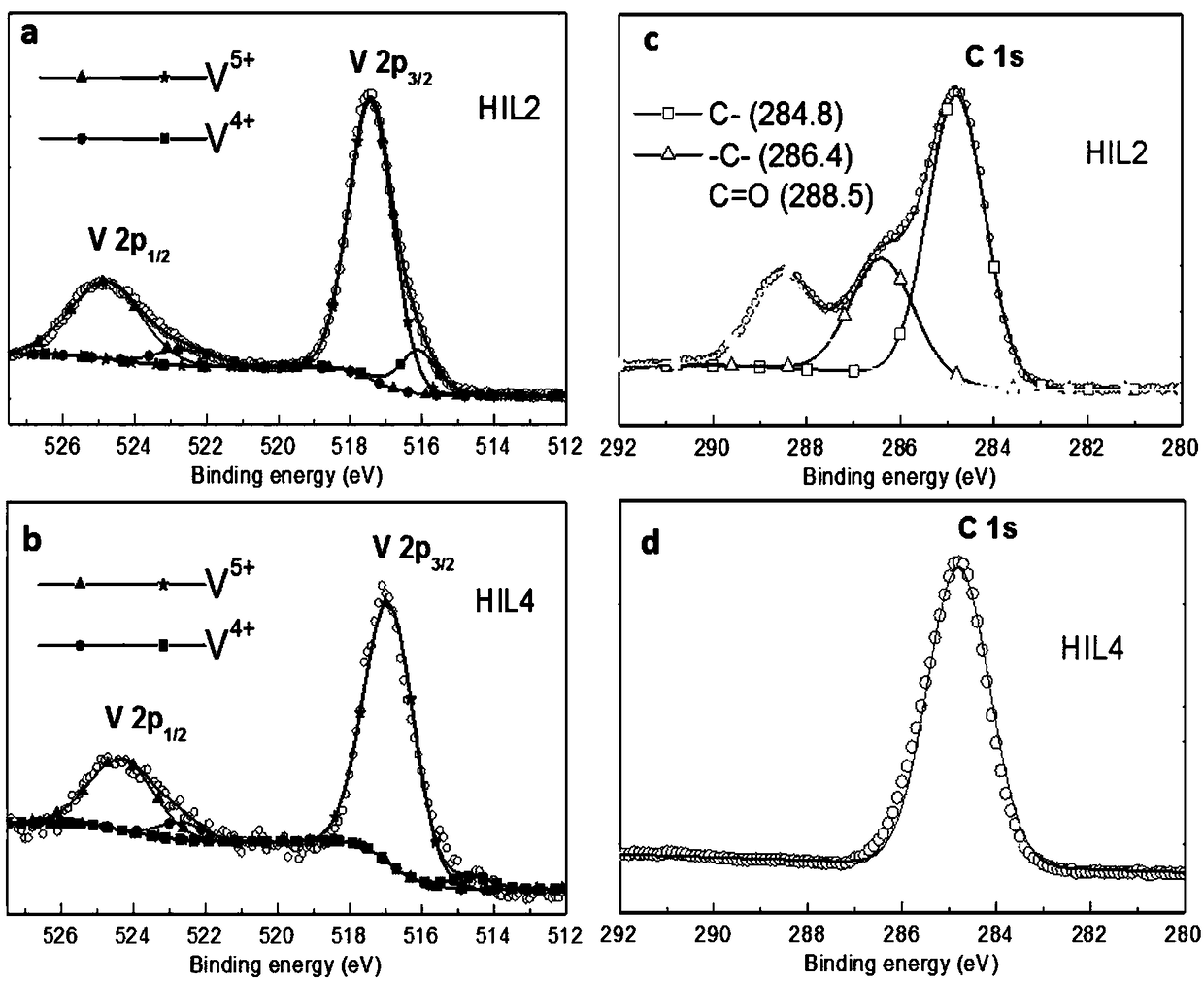Method of preparing hole injection layer in organic light emitting diode based on collosol-gel method and constructed organic light emitting diode
A technology of light-emitting diodes and hole injection layers, applied in semiconductor/solid-state device manufacturing, electrical components, electric solid-state devices, etc., can solve the problems of low solubility, limited vanadium concentration, etc., achieve good repeatability, reduce potential barriers, and wide The effect of concentration tolerance
- Summary
- Abstract
- Description
- Claims
- Application Information
AI Technical Summary
Problems solved by technology
Method used
Image
Examples
Embodiment 1
[0042] VO x Precursor preparation
[0043] according to Figure 8 As shown in the preparation procedure, the V 2 o 5 Disperse the powder evenly in water, take hydrochloric acid, divide the hydrochloric acid into two equal parts and add in two times, the time interval between the two additions is 10s, stir at 65°C until the color of the solution turns yellowish brown; then take hydrazine hydrate, add hydrazine hydrate Divide into two parts on average and add in two times, first add the first part of hydrazine hydrate, stir at 65°C until the color of the solution changes from yellowish brown to blue, then add the second part of hydrazine hydrate; finally add polyvinylpyrrolidone, at 65°C Stir for 2h to produce VO x precursor, where V 2 o 5 The molar ratio of powder, hydrochloric acid and hydrazine hydrate is 11:8.4:0.8, V 2 o 5 The mass ratio of powder and polyvinylpyrrolidone is 2:3.
Embodiment 2
[0045] VO x Precursor preparation
[0046] according to Figure 8 As shown in the preparation procedure, the V 2 o 5 Disperse the powder evenly in water, take hydrochloric acid, divide the hydrochloric acid into two equal parts and add in two times, the time interval between the two additions is 5s, stir at 70°C until the color of the solution turns yellowish brown; then take hydrazine hydrate, add hydrazine hydrate Divide into two parts and add in two times, first add the first part of hydrazine hydrate, stir at 70°C until the color of the solution changes from yellowish brown to blue, then add the second part of hydrazine hydrate; finally add polyvinylpyrrolidone, at 70°C Stir for 2.5h to produce VO x precursor, where V 2 o 5 The molar ratio of powder, hydrochloric acid and hydrazine hydrate is 9:9.5:0.9, V 2 o 5 The mass ratio of powder and polyvinylpyrrolidone is 1.5:6.
Embodiment 3
[0048] VO x Precursor preparation
[0049] according to Figure 8 As shown in the preparation procedure, the V 2 o 5 Disperse the powder evenly in water, take hydrochloric acid, divide the hydrochloric acid into two parts and add it twice, the time interval between the two additions is 20s, stir at 50°C until the color of the solution turns yellowish brown; then take hydrazine hydrate, add hydrazine hydrate Divide into two parts and add in two times, first add the first part of hydrazine hydrate, stir at 50°C until the color of the solution changes from yellowish brown to blue, then add the second part of hydrazine hydrate; finally add polyvinylpyrrolidone, at 50°C After stirring for 3h, VO x precursor, where V 2 o 5 The molar ratio of powder, hydrochloric acid and hydrazine hydrate is 12:8:0.7, V 2 o 5 The mass ratio of powder and polyvinylpyrrolidone is 2.5:2.
PUM
 Login to View More
Login to View More Abstract
Description
Claims
Application Information
 Login to View More
Login to View More - R&D
- Intellectual Property
- Life Sciences
- Materials
- Tech Scout
- Unparalleled Data Quality
- Higher Quality Content
- 60% Fewer Hallucinations
Browse by: Latest US Patents, China's latest patents, Technical Efficacy Thesaurus, Application Domain, Technology Topic, Popular Technical Reports.
© 2025 PatSnap. All rights reserved.Legal|Privacy policy|Modern Slavery Act Transparency Statement|Sitemap|About US| Contact US: help@patsnap.com



